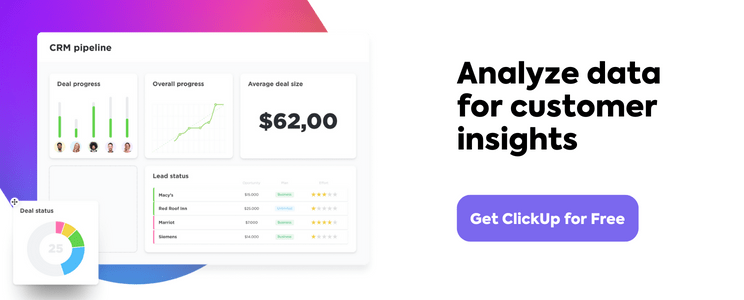

Have you ever been scrolling through your social feed and stumbled upon an ad that felt like it was made for you? Well, it probably was. 🤓
Don’t worry, this article isn’t about the CIA agent living in your phone—it’s about the products those ads are trying to sell you. And more specifically, the products you purchased and absolutely loved.
You know those products. The ones that solved every niche problem, took no time to learn, and made your work life so much easier. Not to burst your bubble, but there was an entire marketing team behind you seeing that ad. And that team probably predicted it from a mile away because you match one of their user personas. 🫱🏼🫲🏾
User personas are part of your marketing planning process that defines who you’re marketing to, how to reach them, and what to say. Basically, it’s a fictitious person who represents your ideal target audience.
It’s vital information not just for marketing teams, but for the design team, sales, and creatives across your organization. Understanding your target users is key to improving a customer’s experience with your product and will heavily influence future product development and messaging.
Whether you’re new to creating user personas or looking to refresh those out-of-date resources, this article is for you! Learn everything to create a competitive and effective user persona as we cover key definitions, elements, templates, and examples to kickstart your process.
What is a User Persona?
A user persona is a somewhat fictional and realistic character who represents your product’s most important user groups. We say somewhat fictional because while this person is ultimately made up, their demographics, role, motivations, and everyday problems are based on real user research and data to help companies better understand the people driving their business.
So even though Barb, Head of HR, is technically imagined by your team, her experience will speak to real users in similar roles, and show them how to benefit from your product. And this builds empathy!
Your users will feel like they’re seen, and in a sense, like you know them. That’s why these resources are more detailed than you’d think.
A thorough persona defines their age, location, lifestyle, everyday activities, and maybe even potential quotes your user persona might say. We’re not saying you need to unpack Barb’s childhood tendencies—but noting that she’s a tech-savvy 37-year-old mom of three who travels year-round while juggling her remote senior-level role, is definitely key.
Why Are User Personas Useful?
User personas (sometimes referred to as the buyer persona) are the first step in understanding the “What’s in it for me?” element that every potential customer is looking for. It’s about knowing their needs, how they like to be spoken to, where they can be reached, and the hook that will pique their interest.
Plus, your product and your strategy will be more successful if you focus your efforts on a select group of people who, statistically speaking, will love your product or service—rather than aimlessly firing off ads into the ether.
Your user persona also informs your messaging, creating a more personalized experience that resonates with users when your target audience interacts with your content or product. And the more you get to know your audience, the more valuable insights you’ll gain into the features and functionality they really want to see.
Here are a few more key ways your user persona fits into your overall marketing strategy:
- Content: Thorough user research will teach you about the type of content to catch your audience’s attention and convert it into a sale. Does your ideal customer prefer short videos? Or long-form writing? The answers to these questions will vary by audience and inform your future content calendar
- Channels: Where are they? You can’t expect customers to flock to you—you have to meet them where they’re at. Knowing their favorite social media platforms, news outlets, and industry events will tell you a lot about your audience’s preferences and will set your business up for success by posting in the places they’re most active
- Campaigns: All of these elements work together to help you create thoughtful marketing campaigns that feel personalized to your users. Knowing what your audience likes to watch, where they like to go, and their general needs and interests will inform the messaging that will resonate with them the most

From there, you can iterate and improve your product’s user experience to further delight your customers—maybe even to the point where they share your product organically. AKA, free marketing. 😍
Elements of an Effective User Persona
No customer wants to feel like they’re just a number, they want to feel seen as real people with very real goals, pain points, and responsibilities. This is why it’s critical to be thorough and thoughtful when creating user personas, starting with these key elements:
Create a user persona header
Your header is essentially your user persona’s first impression, so it needs to be memorable. Lead with an image of your user, plus their name, professional title, and a quote or persona description that tells your team a little more about who this person is.
This brief bio should be easy to read and not exceed a sentence or two. For example, if you run a media and advertising agency in the beauty and wellness industry, common user personas may be someone like Kelly—a co-founder and CEO of a small haircare brand that needs someone to handle the digital marketing side of things so they can focus on new products and growing their business.
As for an image, the depiction of your user should be realistic and match the basic characteristics, personality, and tone of your ideal customer. This will humanize your user personas and make it easier for stakeholders to relate and empathize with your target audience.
With an idea of your user’s image in mind, we suggest searching for an open license or stock images to keep this element of your persona simple and to the point.
A thorough demographic profile and background
The information in your header may be fictional, but it’s all rooted in research! And that research shines through the demographics section of your user personas. Feel free to get as detailed as needed here, consider your customer’s personal and professional background, user environment, and any psychological variables that might inform their lifestyle and choices.
Want to know exactly what to include in the demographic profile? Here’s what we mean:
Personal background
You don’t have to go too deep into this person’s imaginary life, just paint the picture of who they are through fictional personal details. Define important stats like your persona’s age, gender identity, ethnicity and race, education level, and marital status impacting their work life.
For example, our girl Kelly could be a 43-year-old working mom living in Scottsdale, Arizona with a Ph.D. in organic chemistry.
Professional background
This is where you dive a little further into the working side of things. Use current market research to determine your user’s title, realistic income level, work history, and work-life balance.
User environment
What day-to-day necessities do your user personas lean on to get work done in a social, physical, or technological context?
Consider your user’s potential tech stack. Whether this includes that they work in-office or remotely, the number of employees they work with, the time spent in meetings, or how often they’re online during the day, these details matter.
Kelly might work in-office most days of the week but rarely sits at her desk because she’s busy workshopping ideas or preparing for events with the team.
Psychographics
Psychographics is an all-encompassing term to describe your audience’s behavioral patterns, attitudes, interests, opinions, pain points, motivations, and more. Basically, everything that makes Kelly, Kelly. 💜

Feel free to get creative and really specific to target a niche audience. Trust us, if one of your customers is solving a problem using your product, there are likely thousands of others just like them who could benefit in the same ways—they just haven’t found your company yet.
Here are a few of Kelly’s psychographics to get your mind moving:
- Kelly started her haircare company over 20 years ago as a side business to put herself through school but in the last seven years it’s become her full-time career
- Kelly used to be more hands-on with product development, now she spends a lot of her time at trade shows or visiting potential retail opportunities to grow her brand awareness in person
- She sees a lot of value in digital and affiliate marketing but doesn’t know where to start. Her products have a great local presence but she wants to branch out sales across more states
- When Kelly’s not working, she prioritizes her time with her kids and rarely checks her phone outside of work hours. She encourages her employees to do the same!
Your user persona’s end goal and motivation
This is the big why driving your user personas’ behavior and decisions.
This section describes what your user personas want to get out of using your product—the what’s in it for me of it all. Solidifying the proper end goals is the key to understanding what your user personas are trying to fulfill and producing products and messaging that resonate with their vision.
Plus, defining their daily motivations and professional end goal with the problem they’re facing is key to determining whether you’ve found the right audience for your product For Kelly, her goal might be to find a creative agency to handle her branding and online presence from end to end.
You can also expand on this by describing the factors motivating her goal here. Maybe Kelly’s not in a position to manage the business’ digital marketing processes in-house but wants to grow this area of her business without adding another to-do list to her schedule. Just make sure you cover what your users want to achieve and why they’re doing it, and you’ll be in good shape. 🙂
Common pain points and challenges
Knowing your user personas’ motivations will transition easily into the common challenges they face with current products—and what would encourage them to make a change.
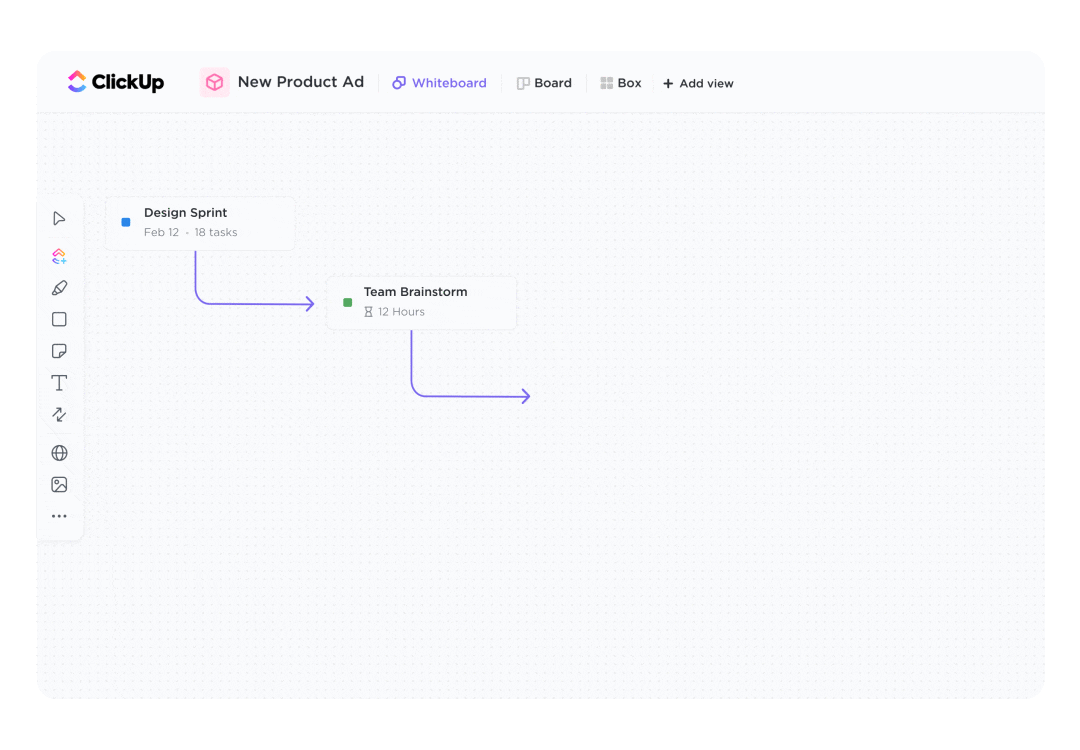
Consider the obstacles that may be preventing your users from achieving their goals or unanswered questions they may repeatedly face. Ideally, your product either fills a void in their workflows or creates a solution that aligns with their daily operations.
Circling back to Kelly, she knows she’s missing out on a ton of potential customers by not leveraging leads from social media advertising, a stronger online presence in general, and cohesive branding. She may also be struggling to find an agency she trusts for several reasons! Possibly from a creative, logistics, or accountability perspective.
A day-in-the-life scenario
This scenario is nothing like the “day in the life” TikToks you secretly love to follow. This is a brief narrative describing how your user personas will discover and interact with your product in order to reach their desired solution or goals.
Far from a literal description of their day, your user persona scenario will be written from their own perspective and inform key use cases for your product down the road!
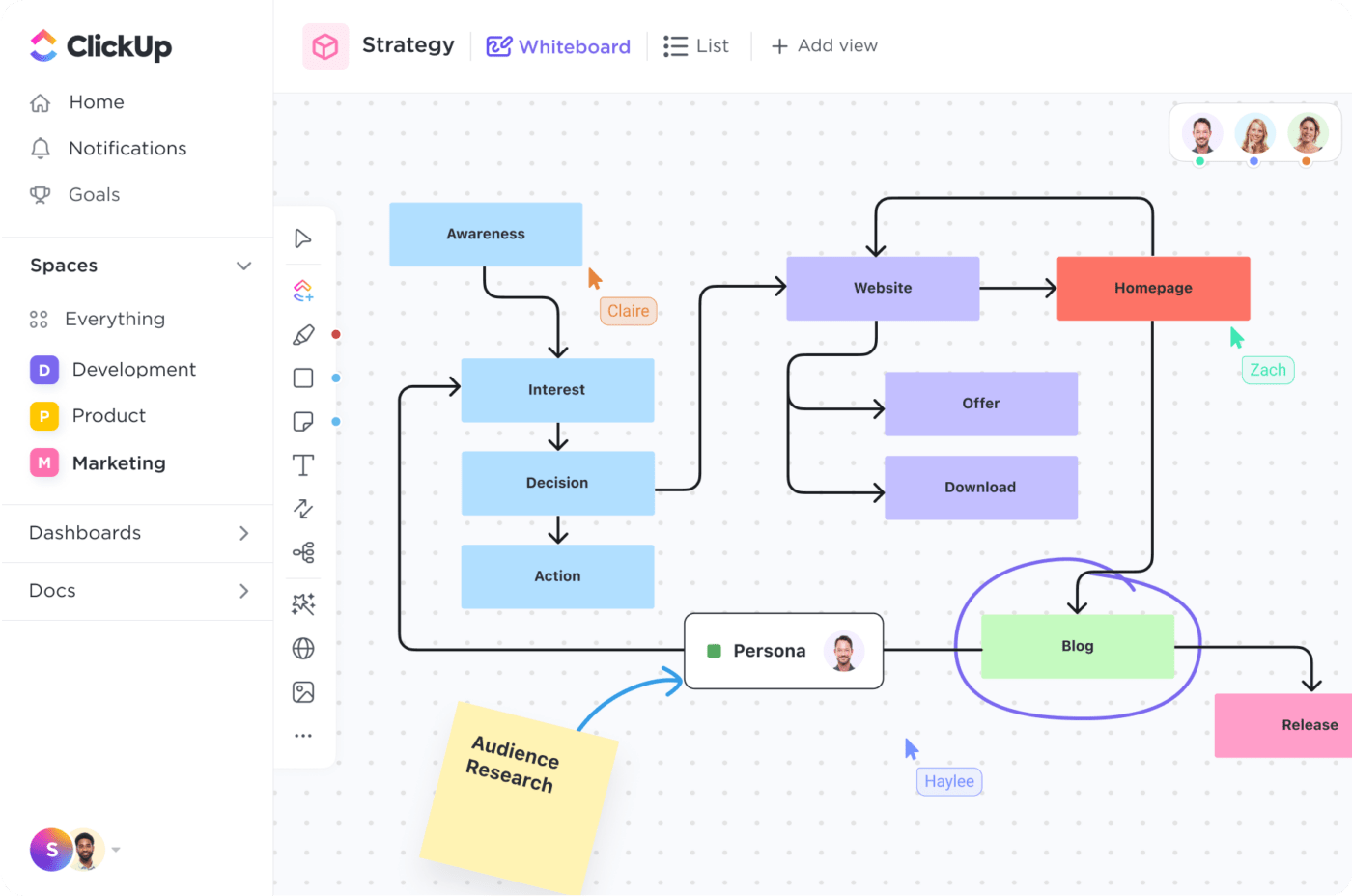
PRO TIP
We suggest keeping your user persona scenario’s on hand for future usability testing and customer journey mapping! Rather than diving into a time-stamped breakdown for your personas, use pieces of information you’ve already collected to weave your story together. No need to exceed 100 words. 🙌🏼
How to Create a User Persona
Now that we’ve covered the essential elements, let’s put our knowledge into practice by creating a user persona! Follow our step-by-step guide to create personas for any industry, product, or service. We’re not leaving you to start from scratch though, keep scrolling for the supportive user personas template you’ve been dreaming of. 🎉
Step 1: Research
Conduct user research and gather data on real users to find the information detailed above including demographics, behavior, and motivations. You can research the old-fashioned way or comb your own CRM software to send out surveys, conduct interviews, and foster real customer connections as you collect data.

Step 2: Look for patterns
Read, re-read, and organize your research to identify any patterns in your results to hone in on your target users. Use these patterns to start piecing together your users’ stories. And bear in mind, you might create more than one persona!
Depending on your product and the type of recurring themes you find in your research, you might discover a new market to tap into and create multiple personas to represent them.
Now that you have your user research and intended users in mind—it’s time to put it all together.
Step 3: Always, always, always use a template!
Software to conduct user surveys, manage tasks, access your customer database, and create designs are all essential in this process. But managing that laundry list of tools is no small feat. Rather than dividing your time across a complicated tech stack and starting from a clean slate with every element of your user persona process, start with a template.
The best templates are customizable, free to use and integrate with all of your other apps to make the user persona process significantly easier and more efficient. Basically, everything ClickUp was designed to do!
ClickUp is the only productivity software powerful enough to centralize your work—across any app—into one, collaborative platform. With an evergrowing list of features to tackle everything from campaign planning to design process execution, ClickUp is your one-stop software for any task.

The User Persona Template by ClickUp has the functionality you need to arrange, organize, and access your profiles with ease. With four project views to manage your profiles and 17 Custom Fields, this List level template gives you a deeper understanding of your audience to build impactful personas.
View your persona profiles at a higher level from your interactive List and even grab key details including their age group, motivation, occupation, goals, and salary from a single glance. This information can be used to filter, group, and sort your list of personas in a matter of clicks, or arranged by gender on a pre-built Kanban board.
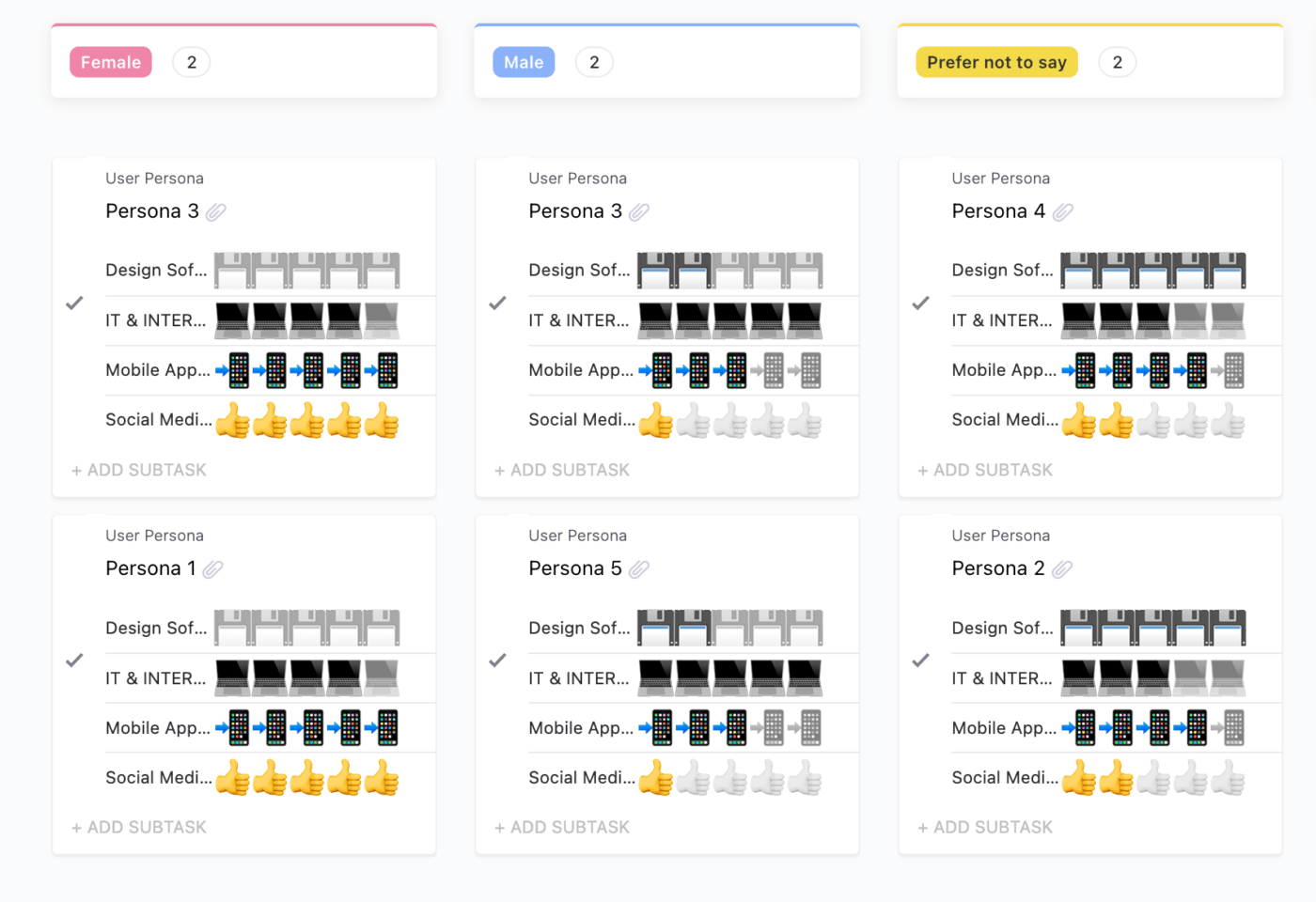
The Getting Started Guide acts as your own personal Help Doc to start using this template like a pro from the second you apply it. And as your product iterates, you can easily update your user profiles from your template to keep them up-to-date at all times.
Step 4: Gather feedback
Once you’ve drafted your user profile, it’s time to double-check your work through thoughtful and repeated rounds of feedback. Validate the persona by sharing it with stakeholders, team members, customers, experts, and more.
Then gather their feedback and adjust as needed. Your user persona may take a few iterations to nail down, and may even change as your product matures. Just remember that the more time you spend getting your profiles just right, the more value they’ll bring to your business.
Using the User Persona Form View in your ClickUp template is perfect for this. Once a team member or stakeholder submits a survey-style request, that potential profile is turned directly into an actionable task for the marketing and design team to research, develop, and possibly approve!
Step 5: Put it to use
It’s time to put your personas to use! 🎉
This may be a piece of your marketing OKRs and strategy, but your user personas are resources for teams across your organization to utilize. Share your profiles with the sales team, your blog writers, UX designers, and customer support representatives so they can better understand who they’re connecting with on a daily basis.
As your business matures, these profiles will be integral parts of your brand guidelines for your UX designer and product management teams to follow. Keep your market audiences front of mind when making big product choices, and creating new features, messaging, and design so it will align still with your audience.
Take Your User Personas Further With ClickUp
There are tons of user persona templates to choose from, so no need to settle on the first one you come by. Plus, your user persona itself is an ongoing resource throughout your marketing strategy—not a one-and-done action item. So finding a template that’s engaging and accessible will do a lot more for you in the long haul.
Our suggestion? Look no further than ClickUp. 🙂
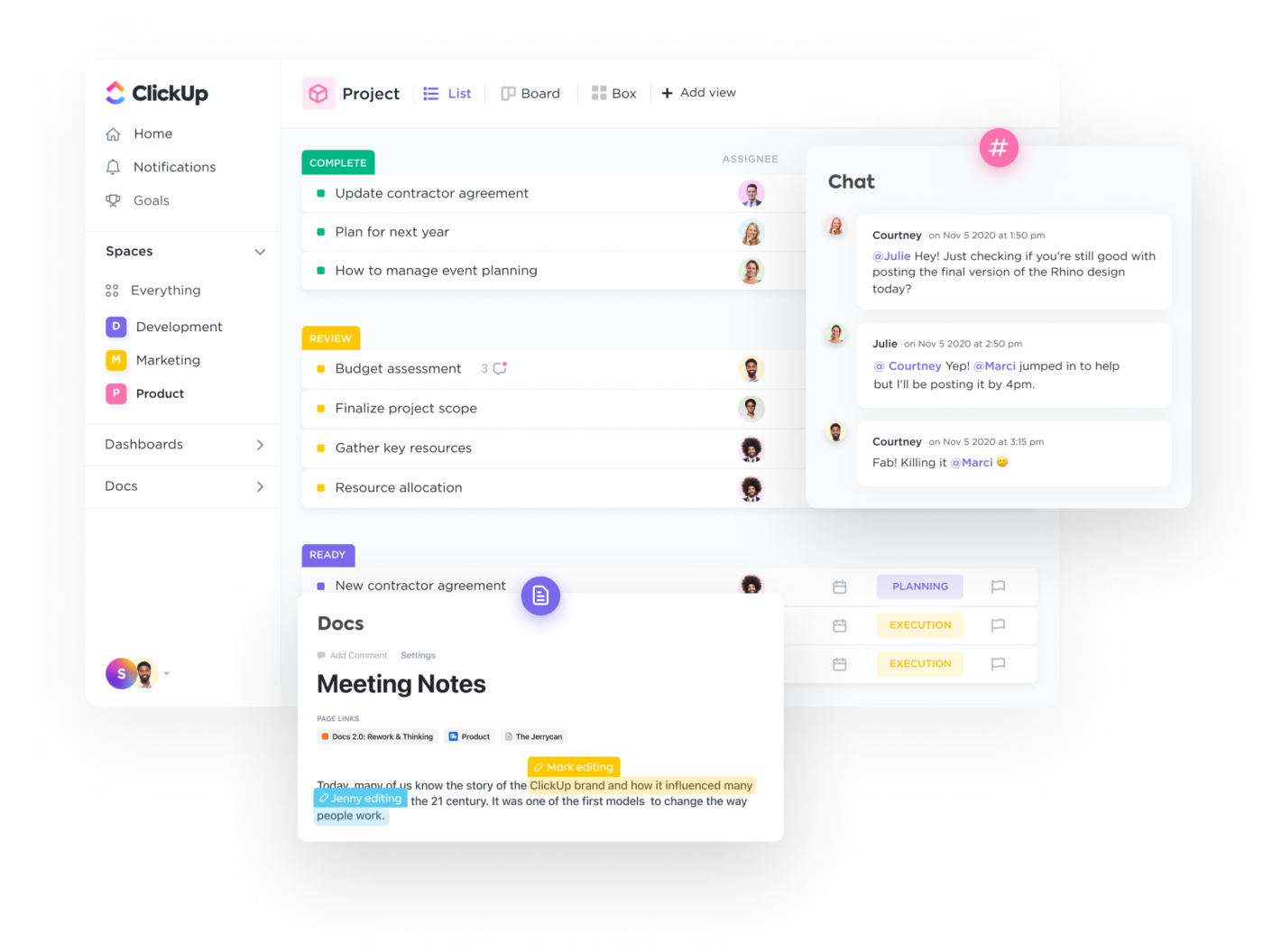
ClickUp integrates with over 1,000 other tools and comes loaded with a vast Template Library for any use case to streamline your processes—including a designated template to create user personas!
Get started with ClickUp for free to start creating personas and watch their profiles take shape in no time!




